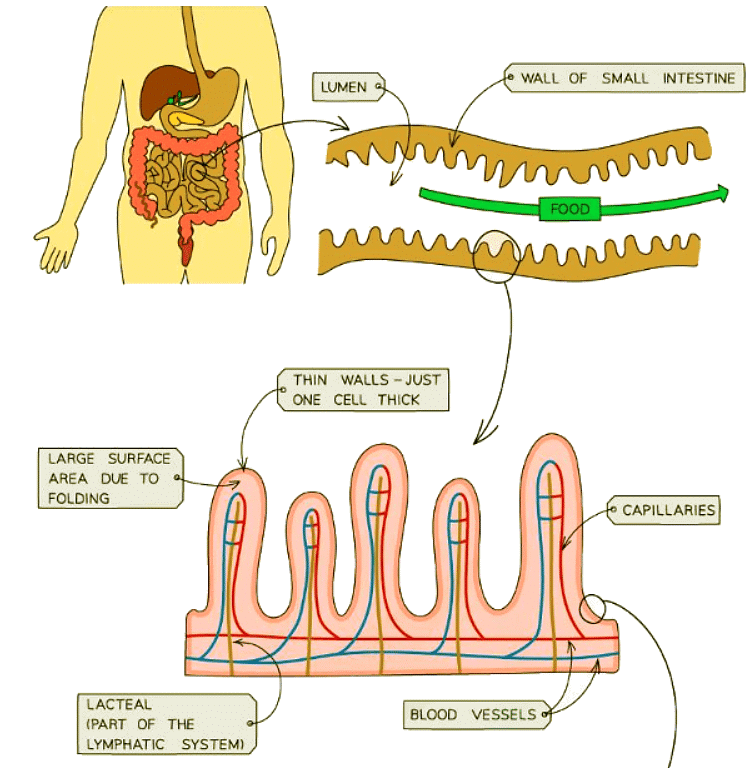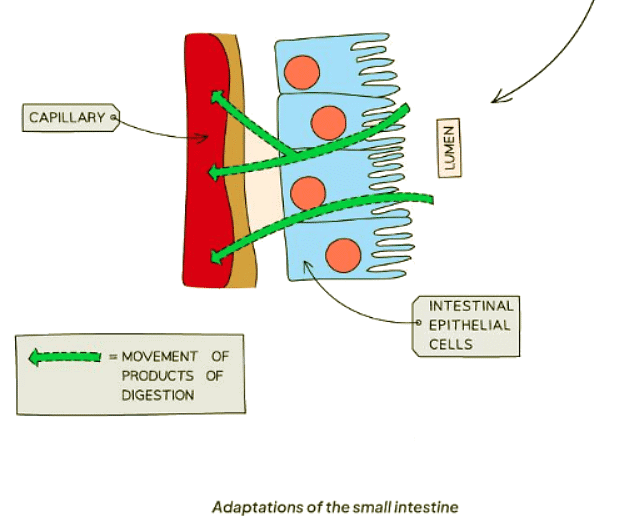Class 10 Exam > Class 10 Notes > Biology for GCSE/IGCSE > Adaptations of the Small Intestine
Adaptations of the Small Intestine | Biology for GCSE/IGCSE - Class 10 PDF Download
Adaptations of the Small Intestine: Extended
- The ileum boasts extensive adaptations for absorption, featuring an elongated structure and a deeply folded surface containing numerous villi, which are tiny, finger-like projections.
- These adaptations significantly augment the surface area of the ileum, facilitating faster and more efficient absorption processes.


- Microvilli: Tiny projections on the surface of the villus that significantly increase the surface area for quicker absorption of nutrients.
- Wall Structure: The wall of the villus consists of a single cell layer, ensuring that the distance for absorption through diffusion and active transport is minimal.
- Blood Capillaries: The villus is well-supplied with a dense network of blood capillaries that efficiently transport glucose and amino acids into the bloodstream from the small intestine.
- Lacteal: A vessel that runs through the center of the villus, responsible for transporting fatty acids and glycerol from the small intestine into the lymphatic system.
Question for Adaptations of the Small IntestineTry yourself: What is the function of microvilli in the small intestine?View Solution
The document Adaptations of the Small Intestine | Biology for GCSE/IGCSE - Class 10 is a part of the Class 10 Course Biology for GCSE/IGCSE.
All you need of Class 10 at this link: Class 10
|
101 videos|193 docs|33 tests
|
FAQs on Adaptations of the Small Intestine - Biology for GCSE/IGCSE - Class 10
| 1. What are some examples of adaptations of the small intestine? |  |
Ans. Some examples of adaptations of the small intestine include the presence of villi and microvilli to increase surface area for absorption, the secretion of digestive enzymes to break down food, and the presence of a large network of blood vessels for nutrient absorption.
| 2. How do villi and microvilli help in the absorption of nutrients in the small intestine? |  |
Ans. Villi and microvilli increase the surface area of the small intestine, allowing for more efficient absorption of nutrients. Villi are finger-like projections that cover the inner lining of the intestine, while microvilli are even smaller projections on the surface of the villi. Together, they greatly increase the surface area available for nutrient absorption.
| 3. What is the role of digestive enzymes in the small intestine? |  |
Ans. Digestive enzymes in the small intestine help break down food into smaller molecules that can be easily absorbed by the body. These enzymes are secreted by the pancreas and small intestine, and they play a crucial role in the digestion and absorption of nutrients.
| 4. How does the network of blood vessels in the small intestine aid in nutrient absorption? |  |
Ans. The network of blood vessels in the small intestine, known as capillaries, helps transport absorbed nutrients to the rest of the body. As nutrients are absorbed through the villi, they enter the bloodstream through the capillaries, allowing them to be distributed to cells throughout the body for energy and growth.
| 5. What are some factors that can affect the efficiency of nutrient absorption in the small intestine? |  |
Ans. Factors that can affect the efficiency of nutrient absorption in the small intestine include diseases like celiac disease or Crohn's disease, which can damage the lining of the intestine, as well as poor diet, certain medications, and digestive disorders. Ensuring a healthy diet, managing any underlying health conditions, and avoiding harmful substances can help maintain optimal nutrient absorption in the small intestine.
Related Searches













